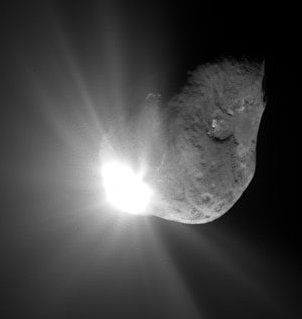
Goddard Space Flight Center, Greenbelt, Maryland 20771
ENGINEERING COLLOQUIUM
Monday, November 21, 2005 / 3:30 PM, Building 3 Auditorium

Daniel G. Kubitschek
"Target Tempel 1: The Challenges of Autonomous Navigation for the Deep Impact Mission"
ABSTRACT -- On July 4, 2005, another first in space exploration was achieved. NASA's Deep Impact spacecraft released a small, 350 kg impactor spacecraft directly into the path of comet Tempel 1 (at the time, estimated to be 14 km x 5 km x 5 km in size). With a closing speed of approximately 10.3 km/s, the Impactor spacecraft autonomously guided itself to impact and captured the highest resolution images ever of the surface of a cometary nucleus, just moments before the collision. The impact event and its corresponding ejecta (the material thrown out in the process of crater formation) were observed in detail from the Flyby spacecraft for a period of 13.3 minutes before the on-board sequence commanded the Flyby to a protective shield attitude for passage through the inner coma. The Flyby spacecraft came within 500 km of the nucleus. This talk will discuss the mission objectives, spacecraft design, challenges of autonomous targeting and tracking, and the encounter performance that led to the successful outcome.
SPEAKER -- Born in 1968 along with an identical twin and the last of 9 children, Daniel Kubitschek grew up in Lakewood, Colorado. He received a B.S. in Mechanical Engineering from the University of Colorado in 1990. After a short, but interesting time working at JHU-APL, he returned to the University of Colorado to attend graduate school in the Department of Aerospace Engineering Sciences. In 1994, he received a M.S. in Aerospace Engineering and in 1997, received a Ph.D. from the same department under the direction of George Born and in the area of Precision Orbit Determination. After 3 years teaching at CU, conducting research, and working on operational orbit determination systems for projects such as QuickSCAT, QuickBird and ICESat, he accepted a position in the Optical Navigation Group at JPL and was assigned to work Autonomous Navigation (AutoNav) for the Deep Impact Project. He served the Deep Impact Project as the AutoNav Team Lead, Impactor Encounter Sequence Design and Test Lead and Flight Director for the Impactor Spacecraft.